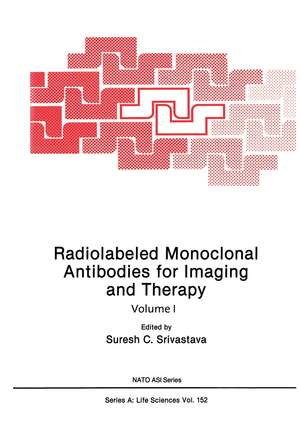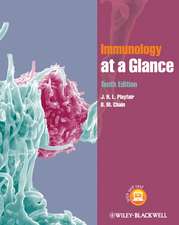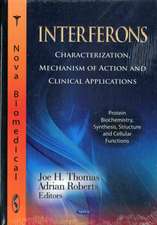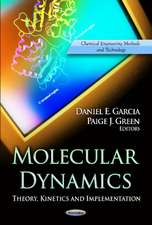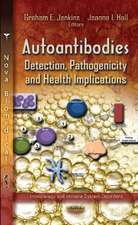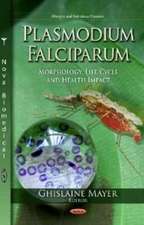Radiolabeled Monoclonal Antibodies for Imaging and Therapy: NATO Science Series A:, cartea 152
Editat de Suresh C. Srivastavaen Limba Engleză Paperback – 18 ian 2013
Din seria NATO Science Series A:
- 15%
 Preț: 656.58 lei
Preț: 656.58 lei - 15%
 Preț: 655.13 lei
Preț: 655.13 lei - 15%
 Preț: 678.35 lei
Preț: 678.35 lei -
 Preț: 397.38 lei
Preț: 397.38 lei - 5%
 Preț: 377.87 lei
Preț: 377.87 lei -
 Preț: 397.76 lei
Preț: 397.76 lei - 18%
 Preț: 1232.41 lei
Preț: 1232.41 lei - 5%
 Preț: 731.64 lei
Preț: 731.64 lei -
 Preț: 413.15 lei
Preț: 413.15 lei - 15%
 Preț: 649.22 lei
Preț: 649.22 lei - 5%
 Preț: 369.45 lei
Preț: 369.45 lei -
 Preț: 407.56 lei
Preț: 407.56 lei - 5%
 Preț: 2162.19 lei
Preț: 2162.19 lei -
 Preț: 407.39 lei
Preț: 407.39 lei -
 Preț: 396.40 lei
Preț: 396.40 lei - 15%
 Preț: 663.93 lei
Preț: 663.93 lei -
 Preț: 387.38 lei
Preț: 387.38 lei -
 Preț: 393.13 lei
Preț: 393.13 lei -
 Preț: 398.35 lei
Preț: 398.35 lei -
 Preț: 401.24 lei
Preț: 401.24 lei - 15%
 Preț: 678.81 lei
Preț: 678.81 lei -
 Preț: 395.09 lei
Preț: 395.09 lei - 18%
 Preț: 952.40 lei
Preț: 952.40 lei - 15%
 Preț: 654.43 lei
Preț: 654.43 lei -
 Preț: 402.00 lei
Preț: 402.00 lei -
 Preț: 401.24 lei
Preț: 401.24 lei - 15%
 Preț: 655.27 lei
Preț: 655.27 lei -
 Preț: 394.71 lei
Preț: 394.71 lei -
 Preț: 384.48 lei
Preț: 384.48 lei - 5%
 Preț: 395.61 lei
Preț: 395.61 lei - 5%
 Preț: 1421.57 lei
Preț: 1421.57 lei - 15%
 Preț: 651.34 lei
Preț: 651.34 lei -
 Preț: 400.10 lei
Preț: 400.10 lei -
 Preț: 386.99 lei
Preț: 386.99 lei - 5%
 Preț: 386.11 lei
Preț: 386.11 lei -
 Preț: 403.91 lei
Preț: 403.91 lei - 15%
 Preț: 651.51 lei
Preț: 651.51 lei -
 Preț: 393.90 lei
Preț: 393.90 lei - 5%
 Preț: 376.43 lei
Preț: 376.43 lei -
 Preț: 400.26 lei
Preț: 400.26 lei - 5%
 Preț: 388.84 lei
Preț: 388.84 lei -
 Preț: 400.65 lei
Preț: 400.65 lei - 5%
 Preț: 740.58 lei
Preț: 740.58 lei - 18%
 Preț: 1225.16 lei
Preț: 1225.16 lei - 5%
 Preț: 386.46 lei
Preț: 386.46 lei -
 Preț: 421.82 lei
Preț: 421.82 lei
Preț: 1138.69 lei
Preț vechi: 1198.63 lei
-5% Nou
Puncte Express: 1708
Preț estimativ în valută:
217.92€ • 226.67$ • 179.90£
217.92€ • 226.67$ • 179.90£
Carte tipărită la comandă
Livrare economică 14-28 aprilie
Preluare comenzi: 021 569.72.76
Specificații
ISBN-13: 9781468455403
ISBN-10: 1468455400
Pagini: 896
Ilustrații: XIV, 876 p.
Dimensiuni: 178 x 254 x 47 mm
Greutate: 1.52 kg
Ediția:Softcover reprint of the original 1st ed. 1988
Editura: Springer Us
Colecția Springer
Seria NATO Science Series A:
Locul publicării:New York, NY, United States
ISBN-10: 1468455400
Pagini: 896
Ilustrații: XIV, 876 p.
Dimensiuni: 178 x 254 x 47 mm
Greutate: 1.52 kg
Ediția:Softcover reprint of the original 1st ed. 1988
Editura: Springer Us
Colecția Springer
Seria NATO Science Series A:
Locul publicării:New York, NY, United States
Public țintă
ResearchCuprins
Immunochemistry of Hybridomas.- Characterization and Selection Criteria of Monoclonal Antibodies for Tumor Imaging Studies.- Tumor Markers and Their Relevance in the Design of Radioimmunoimaging Experiments.- Selection of Monoclonal Antibodies with Optimal Biological Functions for Clinical Application.- Selection and Utilization of Monoclonal Antibody Defined Melanoma Associated Antigens for Immunoscintigraphy in Patients with Melanoma.- Development and Characterization of Human Monoclonal Antibodies and Their Application in the Radioimmunodetection of Colon Carcinoma.- Progress in Diagnostic Immunoscintigraphy and First Approach to Radioimmunotherapy of Colon Carcinoma.- The Design of a Radiolabeled Monoclonal Antibody for Radioimmunodiagnosis and Radioimmunotherapy.- Immunohistochemistry and Correlation with Plasma Levels of CA 19-9 and CEA in Gastrointestinal Tumors.- Optimization of Mouse IgG Fragmentation Technique in the Selection of Monoclonal Antibodies for Myocardial Infarct Imaging.- Sensitivity and Efficacy Indices for Oncologic Data Reporting.- Production and Use of Prospective Radionuclides for Radioimmunotherapy.- Criteria for the Selection of Nuclides for Radioimmunotherapy.- Experience with Iodine-123 Labeled Antibodies.- Radiohalogenation of Antibodies: Chemical Aspects.- Radiohalogenation of Monoclonal Antibodies: Experiences with Radioiodination of Monoclonal Antibodies for Radioimmunotherapy.- Use of Bifunctional Chelating Agents for Radiolabeling Antibodies.- Monoclonal Antibody Labeling with Indium-111 and Gadolinium via DTPA Chelation on Selective and Nonselective Sites of the Antibody.- Important Chemical Variables for Labeling Antibodies with Indium-111 and Technetium-99m.- Potential Labeling of Monoclonal Antibodies with Positron Emitters.- Quantitative Pharmacokinetics of Radiolabeled Monoclonal Antibodies for Imaging and Therapy in Patients.- Kinetic Analysis with Probability Mapping in Radioimmunoscintigraphy.- Biokinetic Studies and Scintigraphic Imaging of Human Carcinoma Xenografts with Radiolabeled Monoclonal Antibodies.- Use of an Animal Model System for Evaluating Labeled Monoclonal Antibodies.- Antibody-Hapten Complexes for Imaging.- Antibody — Carboxypeptidase G2 Conjugates as Potential Tumor Imaging Agents.- In Vivo Kinetics of Iodine-131-Monoclonal Antibodies [anti-CEA and 19-9, F(ab?)2] in Humans.- The National Institutes of Health Experience with Radiolabeled Monoclonal Antibodies: Lymphoma, Melanoma, and Colon Cancer.- Adjuvant Radioimmunotherapy for Micrometastases: A Strategy for Cancer Cure.- Quantitative Imaging and Internal Radiation Dosimetry in the Therapeutic Use of Labeled Monoclonal Antibodies.- The Distribution of Halogenated (At-211 or I-125) Tumor Specific Antibody in Tumor Bearing and Control Mice.- State-of-the-Art and Performance Testing of Instrumentation for the Scintigraphic Detection of Tumors with Labeled Monoclonal Antibodies.- Theoretical Limitations of Tumor Imaging.- Image Subtraction Techniques in Immunoscintigraphy.- Digital Superimposition of Single Photon Emission Computerized Tomography (SPECT) and CT Images for Immunoscintigraphy.- Radioimmunoscintigraphy — SPECT With I-131-MAbs; Comparison with TCT in the Follow-up of Colorectal Cancer.- Comparative Prospective Detection of Recurrences of Carcinomas with SPECT Imaging Using Radiolabeled Monoclonal Antibodies, Ultrasonography and Computed Tomography.- NMR Enhancement with Gd Labeled Antibodies.- Preclinical and Clinical Studies with Indium-111 anti-CEA Antibodies and Fragments.- Clinical Experience inCancer Diagnosis with Radiolabeled Monoclonal Antibodies in 200 Patients and Initial Attempts at Radioimmunotherapy.- Tumor Radioimmunodetection by anti-Melanoma and anti-CEA Monoclonal Antibodies: Pilot and Prospective Studies.- Tumor Immunoscintigraphy: Multicenter Clinical Trials of the Italian National Research Council (CNR).- Interstitial and Intravenous Application of Monoclonal Antibody F(ab?)2 Fragments in the Detection of Lymph Node Metastases: Benefits and Problems with Both Routes of Administration.- Radioimaging of Melanoma and CEA Secreting Tumors by Monoclonal Antibodies Performed by Different Routes of Administration.- A Monoclonal Antibody (Po66-2) Reactive with Human Lung Squamous Cell Carcinoma — Cell Reactivity In Vitro and Preliminary Scintigraphic Trials.- Monoclonal Antibodies Against Human Osteosarcoma: Preliminary Studies.- Radioimmunotherapy of Cancer: Historical Perspectives and Prospects for the Future.- Recent Perspectives on the Use of Radiolabeled Monoclonal Antibodies for Immunotherapy.- Intraperitoneal Therapy of Ovarian Cancer with Radiolabeled Monoclonal Antibodies.- Radioactive Monoclonal Antibodies Against Cell Surface Antigens for Labeling Leukocyte Subpopulations.- Monoclonal Antibody Against Human Fibrin for Imaging Thrombi.- Radiolabeled Antiplatelet Monoclonal Antibodies for the Scintigraphic Localization of In-vivo Thrombi and Vascular Lesions.- Potential of Radiolabeled Antiplatelet Antibodies in the Detection of Vascular Thrombi.- List of Participants.- Author Index.
